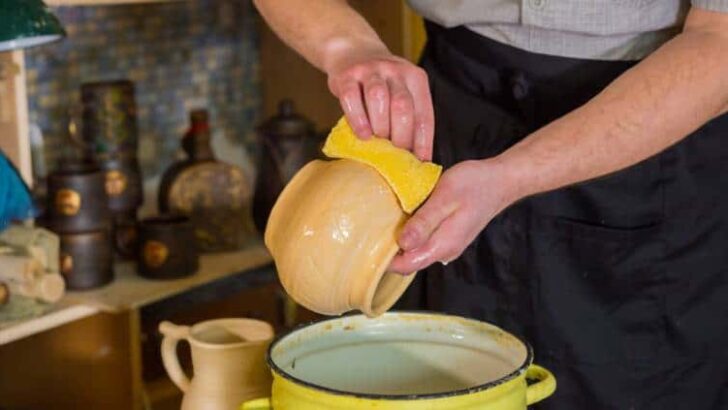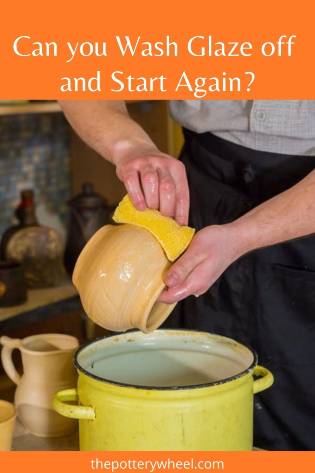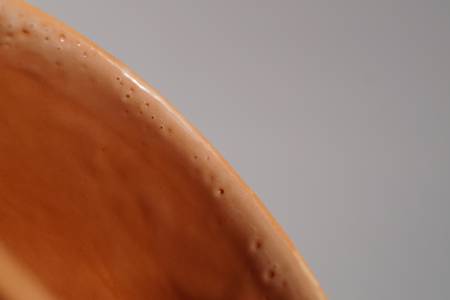Your cart is currently empty!
Can You Wash Glaze off Bisque Pottery?
Published:
Last Updated:

Affiliate Disclaimer
As an affiliate, we may earn a commission from qualifying purchases. We get commissions for purchases made through links on this website from Amazon and other third parties.
There is lots of scope for things to go wrong when you apply glaze to pottery. You can mess up your glaze design, apply the glaze too thick, or even apply the wrong glaze. If your glazing has gone wrong, you’re probably wondering if you can wash glaze off bisque pottery and start again.
Fortunately, you can wash glaze off bisque ware. It can be helpful to scrape some of the glaze off first, then you can sponge it off. You can also use a hose, or run your pottery under the faucet. It’s important to let the bisque dry thoroughly before reapplying glaze.
That being said, there some important factors to be aware of when you wash glaze off bisque ware. So, if you want your glaze reapplication to be successful, then read on for some tips….
This article is split into 4 sections. They are the why, what, how, and when of washing glaze of bisque pottery. If you are especially interested in one section you can jump straight to it with these links:
- Why wash bisque pottery?
- What can happen when you wash glaze off bisque?
- How to wash glaze of bisque pottery
- When to reglaze once you have washed the glaze off

Let’s start off with the question of why you might wash glaze off bisque….
Why Wash Glaze off Bisque Pottery?
It’s easy to make mistakes when you are glazing. Even experienced potters can mess up, or simply change their mind and want to start again with a glaze.
The good news is that you can wash glaze off bisque ware. In fact, lots of potters wash bisque before they glaze it, as a matter of course.
There are a few reasons why potters wash bisque ware before glazing. One of the reasons for this is that bisque that has been sitting on a shelf might be quite dusty. Also, bisque often has a fine layer of ceramic dust on it once it comes out of the bisque fire.
Small particles of dust and ceramic debris on the surface can cause problems with your glaze finish. Contaminants on the surface of your bisque can cause pin holing in your glaze. Pinholes are small holes in the glaze that look a bit like pinpricks.

Dust is also thought to cause glaze crawling, where the glaze balls up on pottery when it is fired. This leaves bare patches of unglazed ceramic once fired. And the glaze itself looks a bit like curdled milk.
It’s sometimes said that washing bisque before it is glazed prevents problems with the glaze finish. Some potters wipe their bisque with a damp or wet sponge. Others run it under the faucet and some dip it in a bucket of water.
However, like lots of things in ceramics, different potters have different practices. And some potters never wash their bisque ware and don’t encounter any glazing problems.
In fact, there are some good reasons to avoid washing bisque ware before you glaze it. And that is what I will cover in the next section…
What Can Happen if you Wash Glaze off Bisque?
Bisque pottery is dry and porous, and it absorbs liquid readily. This is one of the reasons that glaze adheres to bisque ware. The dry bisque sucks the water out of the glaze, and the glaze materials stick to the ceramic surface.
If you wash your bisque pottery, the fired clay soaks up a lot of water. As a result, it becomes less absorbent. When you then apply glaze, less of the water is absorbed from the glaze. And consequently, less of the glaze materials adhere to the pottery.
Thin or Uneven Glaze
This can result in a glaze coating that is overly thin or unevenly applied. Some areas of the glaze might be thicker than others, leaving an uneven patchy finish.
For this reason, if you do wash glaze off bisque pottery, it’s important to let it dry sufficiently. It’s often recommended that you leave bisque a day or so to dry out properly after washing.
But, of course, this depends on the temperature of the room and how humid the atmosphere is. I will say more about how long to leave the bisque to dry a little later.
Glaze Imperfections
Some potters find that washing glaze off bisque then reglazing simply does not look good once fired.
One reason for this might be that the original glaze left some residue behind on the bisque. If the original glaze is not compatible with the new glaze that is applied, this can cause glaze defects.
Even if you wash glaze off bisque well, it stands to reason, that traces of the original glaze will remain. If you then apply a different glaze on the washed bisque, it may interact unfavorably with this residue.
Effective glazing is largely a matter of chemistry, and if you mix your glazes unintentionally, the glaze chemistry will change. And this can bring unexpected results. You may be lucky and have an interesting glaze interaction that works well. Or your finished piece may have problems such as pin holing, crawling, or look cloudy.
Having said that, if you are reapplying the same glaze, then you don’t have the same problem. And chances are, provided you leave the bisque to dry sufficiently, that the reapplied glaze will look fine.
How to Wash Glaze Off Bisque and Start Again
Here are some of the ways that you can wash glaze off bisque. The method you choose depends on the pottery you are handling. For example, if your bisque is delicate with fine detail on it, it’s best to use a gentle approach.
- Using a wet sponge to carefully wipe the glaze off.
- Running the ceramics under a faucet and rubbing with your fingers or a cloth.
- Hosing the glaze off. Some potters use a hose with a bit of pressure in the water jet to remove glaze. I honestly haven’t tried this myself, and I think I’d be too nervous to do it. But it works for some!
- Soaking the glazed bisque in a bucket of water to soften the glaze. Then rubbing the remaining layers of glaze away.
Removing the glaze from the inside of a pot can be more tricky. Particularly if the pot is narrow enough to make it hard to reach your hand inside.
One method of washing glaze off bisque on the inside is to use a bottle brush. Or alternatively, you could use a sponge on a stick.
Scraping off the Glaze?
You might also find that you can scrape some of the dried glaze off too. This can be done using a plastic or metal rib tool.
Dried glaze is quite powdery and will scrape off relatively easily before it’s fired. If you want to try scraping some of the glaze off, it’s best to do this outdoors. Glaze dust, like clay dust, can get everywhere and you should avoid inhaling it.
As well as scraping the glaze outside, you should also wear a respirator to avoid inhalation.
However, scraping will not remove all of the glaze. So, you will still need to wash the remnants of glaze from the bisque.
How Long to Let Your Bisque Dry?
Exactly how long to leave your washed bisque to dry before reglazing depends on a few factors. Some potters will leave their bisque to dry for 15 minutes. Others will leave the bisque to dry for a couple of days.
Here are some of the factors that affect how long you will need to let the bisque dry:
How Wet Did the Bisque Get?
Running the bisque under a tap will make it wetter than wiping glaze off with a damp sponge. The more water the bisque absorbed the longer it will take to dry.
It’s worth noting that the bisque will look dry fairly quickly. But even if it looks dry it can still contain quite a bit of water. Hold it to your cheek and if it feels cold, it likely needs to be dried for longer.
Having said that, if you work in a cold climate, bisque will usually feel cold on your cheek. So, this may not be the easiest way to gauge if the bisque is still wet. If in doubt, leave the bisque for a little longer to dry.
What is the Humidity Like?
If you are working in a humid atmosphere, it will take longer for the bisque to dry out.
Some potters will speed up the drying process by putting their bisque on top of a warm kiln. An alternative is to put your domestic oven on a low, warm temperature like 212F (100C). The pottery can then sit in the oven for a little while to help evaporate the water.
One advantage of warming the pottery up is that glaze dries more quickly on warm bisque.
The Type of Glaze You are Using
Some glazes will adhere more successfully to slightly damp bisque than others. So, it can be hard to state a hard and fast rule regarding how dry the bisque needs to be.
In fact, some potters deliberately wet their bisque before they apply glaze. They find that it helps with some glaze defects like pinholing.
Experienced potters who know their glazes well sometimes find that they get a more even glaze coverage on damp bisque. And wetting bisque is sometimes used deliberately to get a thinner coat of glaze.
Having said that, when you are learning about glazing, it is probably best to leave the bisque to dry thoroughly. A good rule of thumb is to let the bisque dry out overnight at least. Once the bisque is dry, you should be able to apply the glaze again without encountering problems.
Final Thoughts
Learning about ceramics and pottery is an ongoing learning process. Mistakes and mishaps are inevitable. I have a box of fired ceramics that I call ‘pottery gone wrong’. It’s where I consign some of the more interesting experiments that have not gone to plan.
If you make a mistake with your glaze, don’t worry, it happens. You can simply wash glaze off bisque and start again. You are unlikely to encounter problems provided you wash the glaze off thoroughly. Do wash it well if you are going to reglaze with a different type of glaze. And, if you let the bisque dry completely, you will have a blank slate to start again with.



